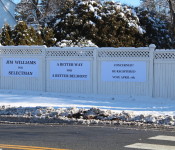Photo: The owners of Jimmy’s Food Mart, Surinder Kaur Dhaliwal and Parmjit Singh with their attorney, Steve Rosales, before the Board of Selectmen.
Citing a precedence in opposing past applicants which failed a fluid set of criteria, the Belmont Board of Selectmen unanimously denied a license to Jimmy’s Food Mart to sell beer and wine from the store at the corner of Belmont and School streets.
“This is about fairness,” Selectman Sami Baghdady told the Belmontonian after the meeting held on Monday, March 16, referring to the board’s recent denials to a pair of Trapleo Road businesses which failed to meet a benchmark of requirements set when the board OK’ed a full liquor license for the Loading Dock on Brighton Street in May 2014.
“If we denied LC Variety and Trapelo Variety
The board’s decision now places the future of Jimmy’s Food Mart into question.
“I don’t know if we can stay open,” said co-owner Parmjit Singh told the Belmontonian after the meeting.
Singh said he heeded the board’s suggestions made by the board three weeks prior when he and his wife and co-owner Surinder Kaur Dhaliwal, first presented their application for a beer and wine license.
“We did all they asked. Why did they now reject us? The business is changed to what they wanted,” he asked Belmont attorney Steve Rosales, who represented the couple.
In their application, the owners informed the town the store would provide popular and affordable brands of beer and wine, products in demand as the four current beer and wine and full liquor license holders in Belmont are providing selections that are viewed as more selective.
“I don’t know about you, but I like,” said Rosales.
At the meeting in February, the board informed the couple it would view their license application more favorably if they fundamentally changed their business model from a corner store selling the staples and sundries into food preparation and a “market”-style operation. The meeting was continued until this Monday.
Singh and Dhaliwal bought the shuttered site of the former Shore Drug in 2013 and opened it as a convenience store in January 2014. The store is managed by their son and business partner, Jimmy Singh. Since opening, neighborhood reaction has been overwhelmingly favorable, with residents commending the owners for operating a clean and inviting business.
Hannah Haynes, who lives on Lewis Road, said Singh polices the area including keeping the sidewalk clear of snow beyond the business’ boundaries and conveniently staying open into the night.
“For someone who works late, I appreciate the light and activity the store brings to the street,” Haynes told the board.
Since the February meeting, the store has set aside a significant square footage of floor space to accommodate South Asian foods, products and fresh “to-go” foods, transforming the store into an “international” market. Singh said he has not yet created a spot to serve or consume food since he would need to obtain a common victualler license.
While praising the new business plan the board strongly suggested Singh and Dhaliwal adopt, and the owners’ decision to voluntarily end tobacco sales, Baghdady said the business, “still doesn’t feel right to me that you have lottery sales.”
“Honestly, [lottery sales] is inconsistent with your business plan,” said Baghdady, telling the owners they would “do better if you got off the lottery and focused on the ethnic food products.”
Singh told the board lottery sales allows the store to stay in operation, providing the business a small profit to soften the high cost of doing business at the site including a $4,000 a month rent in addition to other fees and taxes he must pay.
“I need the lottery. It’s very hard for me to make my money [from the store alone],” said Singh, noting that similar Indian stores in Somerville, Cambridge and surrounding areas all sell lottery tickets to customers who are from South Asia.
Baghdady would not budge from his and the board’s demand the store abandoned lottery sales, noting the “precedence” set in rejecting two previous applications.
Rosales told the board the precedence from the Loading Dock decision was if an establishment wanted a full liquor license, “then you give up [lottery and tobacco] sales.”
The pleas did not move the board.
“I clearly understand that the lottery is a revenue source, but I don’t think you have it tonight, unfortunately,” said Selectman Mark Paolillo.
In addition, the Board noted traffic issues existed on nearby Lewis Road – running perpendicular to Belmont on the same block as Jimmy’s – which could be exasperated with vehicle traffic from Jimmy’s customers.
While Lewis Road residents were critical of the parking and traffic on the roadway at the February meeting, they were nearly universal in commending the owners in their commitment to operating a neighborhood-friendly store.
“I encourage you to keep working on your business plan, expand your business and when you’re ready, then come back,” said Baghdady, suggesting a return is possible in “eight months.”
“I don’t know how they are not ready now?” queried Rosales.
The board voted to accept Baghdady’s “itemized reasons” for denying the application; “I don’t think the use is capable with that neighborhood, I think a lottery license is incapable with our previous decisions and until the Traffic Advisory Committee does take some action on Lewis Road, I think this affects traffic in the residential areas.”
When asked if the board has established a “criteria” for future beer and wine applicants must follow, Baghdady said the board’s new “guidelines” should be taken into consideration by any business seeking a beer and wine license.
“They should know what we expect from applicants,” said Baghdady.
The presence of an unwritten set of rules applying troubled Rosales, a past member of the Board of Selectmen.
“Let me just say personally, [unwritten guidelines] would have been unthinkable when I was a member of the [board of selectmen],” Rosales told the Belmontonian.
When asked to elaborate, Rosales declined with a shake of the head.
When asked if the board has established a criteria future beer and wine applicants must adhere to, Baghdady said the board’s new “guidelines” should be taken into consideration by any business seeking a license.
“They should know what we expect from applicants,” said Baghdady.
When told of the possible closure of the year old operation, Baghdady said the owners should not have based a business decision on the “hope” they would receive a beer and wine license.
“They should have made opening the business contingent on receiving a license, not the other way around,” he said.




